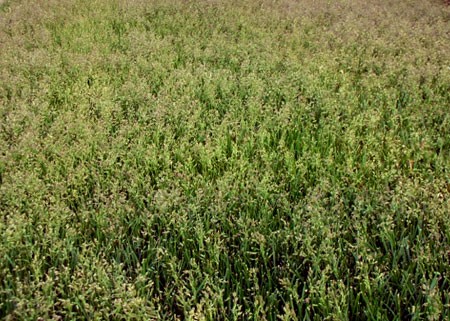Seedheads in lawns are a natural process that can’t be avoided, but keeping your mower blade sharp and applying fertilizer will keep the lawn healthy and looking good.
Kevin Frank, Michigan State University Extension, Department of Plant, Soil and Microbial Sciences –
The cool season turfgrasses growing in Michigan have been in full-blown seedhead production mode in the last week. The common lawn grasses, Kentucky bluegrass, perennial ryegrass and tall fescue all produce seedheads as do some grassy weeds like annual bluegrass (Poa annua). Seedhead production requires energy from the plant, so it is likely the turf will not only look stemmy due to the seed stalks, but the turfgrass may even thin out.

Seedheads in turf. Photo credit: Kevin Frank, MSU
Michigan State University Extension says to consider a fertilizer application following the seedhead flush to help the turf recover, especially if you haven’t fertilized yet this spring or fertilized back in April. Keep the mower blade sharp and don’t lower the mowing height to try and remove seedheads. Annual bluegrass produces seedheads below the 1/8-inch mowing height on golf course putting greens, so lowering the mowing height is not going to solve the seedhead problem.
For those that think the lawn is going to be reseeded by the natural seedhead production, think again. Even if the seed was allowed to reach maturity, which would take about four months, allowed to dry, and then harvested, you’d still need to make sure that seed would find a home in the soil in order to germinate. If you need to fill in some areas in your lawn, it’ll be easier and more effective to go buy some seed.


